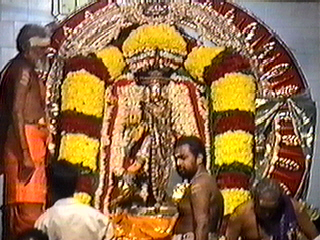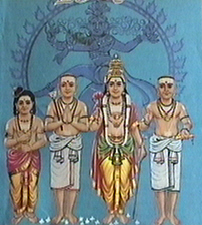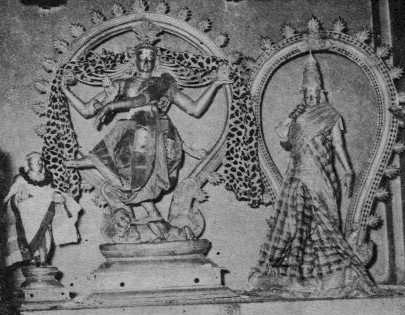Weekly Feature - Dec 20, 1999 Abodes
of Shiva Templenet - The Ultimate Source of Information on Indian Temples For more information, please contact: ©1996 K. Kannikeswaran Templenet where Tradition Meets Technology |
Manikka Vaachakar, a Saivite saint of the first millennium CE (the author of celebrated works such as Tiruvaachakam, Tiruvempaavai and Tiruppalliezhuchi), was closely associated with the Chidambaram Natarajar temple, and is believed to have merged with Natarajar, in the central shrine there. The Manikkavaachakar festival, involving the chanting of the Tiruvempaavai, and a procession of his image, is also celebrated in several of the Saivite temples throughout Tamilnadu. Although there is a shrine to Natarajar, in virtually all of the Saivite temples in Tamilnadu, five of these are considered to be the Pancha Sabhais or the five cosmic dance halls of Shiva. The five dance halls are The Hall of Gold - Kanakasabha at Chidambaram, The Hall of Silver Velli Sabhai at Madurai, The Hall of Rubies - Ratnasabha at Tiruvalankadu, The Hall of Copper - Tamrasabha at Tirunelveli and The Hall of Pictures - Chitrasabha Kutralam Festivities: Arudra Darisanam at Tiruvalankaadu enshrining Nataraja in the Oordhva taandava posture, is the grandest festival here in this obscure village near Chennai, attracting devotees from the neighboring villages. The Velli Sabhai or the silver hall at the Meenakshi Sundareswarar temple at Madurai, bears a stone image of Nataraja and a festival image, both with their right foot raised (in response to pleas by a Pandya ruler, who was appalled by the thought of Nataraja's right foot becoming weary, thanks to his constant dance, with his left foot raised.) The Periya Sabhapati shrine, the Sandana Sabhapati shrine are scenes of festivity at the Nellaiappar temple during Arudra darisanam. The festival image of Natarajar is housed in the ornate Tamra Sabha, and the cosmic dance of Shiva is enacted on the occasion. At Kutralam, the festival image of Nataraja is taken from the Kutralanathar temple to the Chitra Sabha, and the Taandava Deepa Araadhanai is performed there. Arudra Darisanam festival at Tiruvarur has been referred to in the hymns of the Tevaram saints (7th century). Also mentioned in the Poompaavai patikam of Tirugnanasambandar are the Arudra Darisanam celebrations in the Tirumayilai Shivastalam (the Kapaaleeswarar temple in the heart of the modern city of Chennai). Other Nataraja shrines of significance: The Kudandaikkeezhkottam houses a grand shrine to Natarajar, and so does the Patteeswarar temple at Perur near Coimbatore. The Chandramouleeswarar temple at Tiruvakkarai near Villuppuram features Natarajar with his right foot raised. Utthirakosamangai near Rameswaram, revered by the hymns of Manikkavaachakar, is also known for its grand shrine to Natarajar and is the scene of grand festivities during Margazhi Tiruvaadirai. The grandest of all these festivities happens at the Natarajar temple at Chidambaram, where the Margazhi Bhramotsavam, or annual festival is celebrated for a period of 10 days. Hundreds of thousands congregate from far and wide to witness the climax of this festival on the day of Arudra Darisanam. The first day of festivities (Dec 14, 1999) is marked by the hoisting of the temple flag, and a procession of the images of the Pancha Murthys (Somaskandar, Ambal, Vinayakar, Subramanyar and Chandikeswarar). The fifth day of the festival is considered to be of great significance and is referred to as the 'Teruvadaichaan tiruvizha'. The seventh day (Dec 20), is marked by a procession on the Golden Kailasam and the silver elephant mounts. The eighth day (Dec 21) witnesses a procession of Bhikshatanar commemorating legends associated Shiva's and Vishnu's trip through Dhaarukaavanam in the guise of Bhikshaatanar and Mohini. It is only on the ninth day (Dec 22), that the image of Natarajar from the central shrine is taken out in procession in a grand chariot through the streets surrounding the temple. Tens of thousands of devotees drag the massive chariots through the Maada veedhis (processional streets), following which, the images of Natarajar and Sivakami are brought to the 1000 pillared hall of the vast temple. In the pre-dawn hours of the next day (Dec 23), under the full moon, an abhishekam is offered to the images of Natarajar and Sivakami in the 1000 pillared hall (the Raja Sabha), followed by a Royal Audience in the same venue, where thousands of devotees line up for a fleeting glimpse of Natarajar. The cosmic dance of Shiva is enacted later that afternoon, featuring the revered images of Nataraja and Sivakami decked in regal finery; the images are then taken back to the innermost sanctum. Manikkavaachakar's association with Chidambaram is celebrated throughout the festival.
All Visit the Adiyaar section of the Saiva Siddhanta website for more information on the works of Manikkavaachakar. The Saiva Siddhanta website contains the hymns of Tiruvempaavai and Tiruppalliezhuchi and Tiruvaachakam. Temples of Tamilnadu][The Templenet Encyclopedia -
Index to States] |
|

 in the year (coinciding with the asterism of Tiruvadirai in the tamil month
of Margazhi) marks the auspicious time for Arudra Darisanam - of Nataraja in Saivite
temples all over Tamilnadu. Arudra Darisanam, this year falls on December 23, 1999.
Coincidentally the last full moon of the millennium falls on the last winter
solstice of the millennium.
in the year (coinciding with the asterism of Tiruvadirai in the tamil month
of Margazhi) marks the auspicious time for Arudra Darisanam - of Nataraja in Saivite
temples all over Tamilnadu. Arudra Darisanam, this year falls on December 23, 1999.
Coincidentally the last full moon of the millennium falls on the last winter
solstice of the millennium.
 processions are led by an image of Manikkavaachakar. The Tiruvempaavai
hymns composed by the saint are chanted every evening, when an image of the saint is
brought to the shrine of Nataraja from the Deva Sabha and placed in front of the
Kanakasabha. Each of the 20 Tiruvempaavai is chanted by a congregation of hundreds of
devotees led by an Oduvaar; and at the end of each verse, temple bells are rung, and lamps
are waved. The image of Manikkavaachakar is taken back to the Deva Sabha at the
culmination of the recitation.
processions are led by an image of Manikkavaachakar. The Tiruvempaavai
hymns composed by the saint are chanted every evening, when an image of the saint is
brought to the shrine of Nataraja from the Deva Sabha and placed in front of the
Kanakasabha. Each of the 20 Tiruvempaavai is chanted by a congregation of hundreds of
devotees led by an Oduvaar; and at the end of each verse, temple bells are rung, and lamps
are waved. The image of Manikkavaachakar is taken back to the Deva Sabha at the
culmination of the recitation.